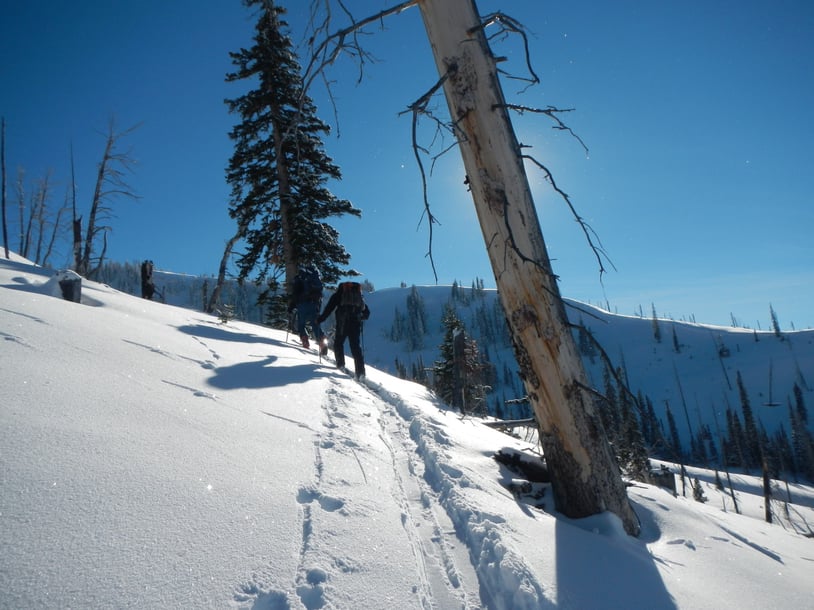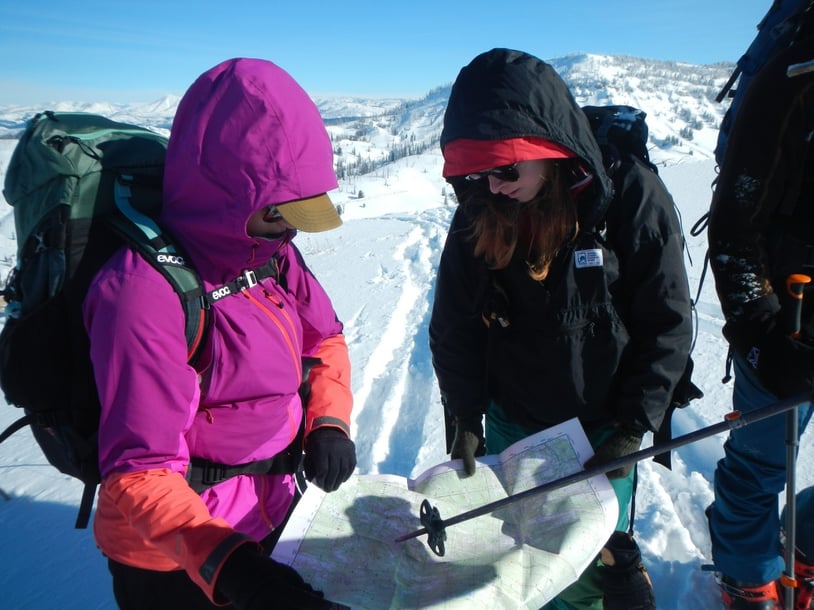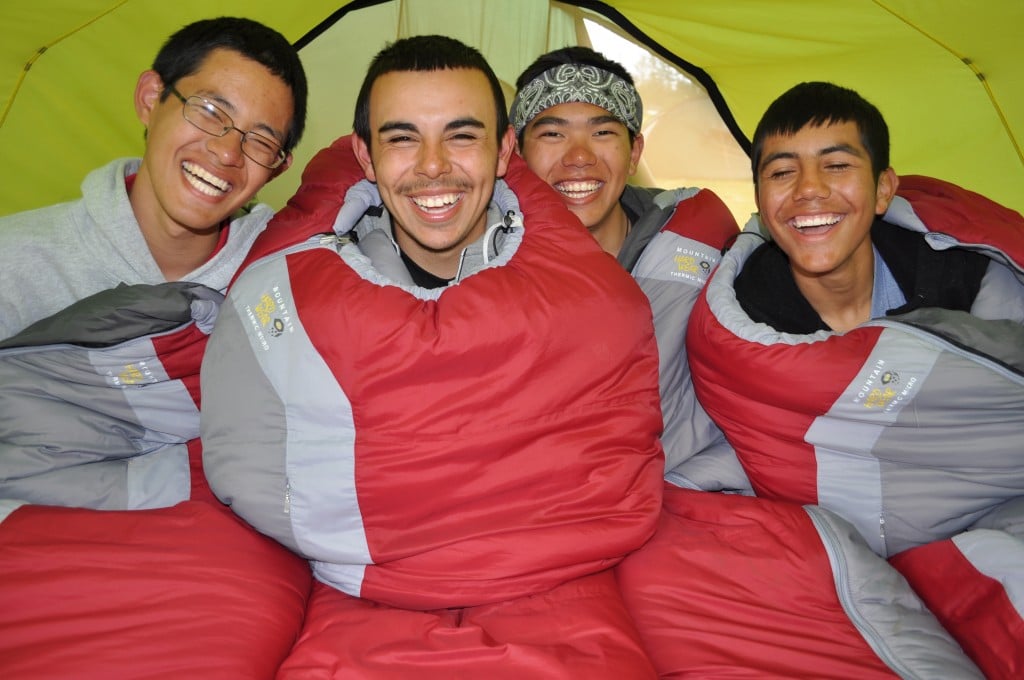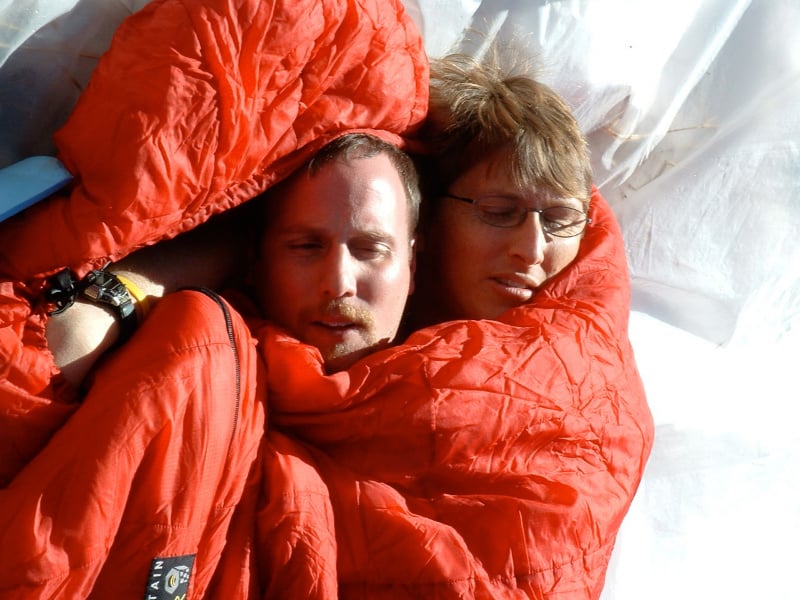
Editor’s Note: This case study is based on a real-life incident from the early 1980’s. This study was updated in 2024 to include more information about treating hypothermia.
You and three friends are on an early winter ski trip. To shorten the route, the group decides to cut across a lake, despite previously agreeing to avoid the lakes due to thin ice.
About 20 yards from shore you warn the others of “funny ice,” and suggest the group turn around. As you stop to talk it over with your companions, you break through the ice and sink up to your chest. Fortunately, the sled you’re towing keeps you from falling through completely.
Remembering the scene size-up priority of rescuer safety (and scared they would also break through), your companions retreat to safety. They coach you to relax, which you find amusing considering you’re the person in the water. You unbuckle your pack and sled, but then slip into the water up to your chin. You struggle for a few minutes, gasping and hyperventilating, before realizing you are standing on the lake bottom. After calming your breathing, you release the ski bindings and, with the help of your companions, you crawl out of the water onto the ice, and roll away from danger.
The light is fading and the sun is ending its all too brief appearance. It is 15°F (-9.4°C). Your clothing and hair quickly freeze. You are shivering.
SOAP Report
Subjective
The patient is a 26-year-old who fell into a lake while skiing, and was able to self-extricate after 5-10 minutes. The patient is presently complaining of being very cold, shivering violently, and is unable to help themself.
Objective
Patient Exam
The patient was not submerged and has no apparent injuries.
Vital Signs
|
Time |
4:30pm |
|
Level of Responsiveness (LOR) |
A+OX4 |
|
Heart Rate (HR) |
110, strong, regular |
|
Respiratory Rate (RR) |
28, shallow, regular |
|
Skin Color, Temperature, Moisture (SCTM) |
pale, cool, dry |
|
Blood Pressure (BP) |
strong radial pulse |
|
Pupils |
PERRL |
|
Temperature (T°) |
not taken |
History
|
Symptoms: |
None |
|
Allergies: |
Unknown |
|
Medications: |
Occasional non-prescription pain medication, none taken today |
|
Pertinent Hx: |
None relevant |
|
Last in/out: |
Breakfast & lunch today, 2 liters of water during the day |
|
Events: |
None relevant |
Pause here!
What is your assessment and plan? Take a few minutes to figure out your own assessment and make a plan before you read further.

Assessment
Patient is mildly hypothermic but at risk of becoming seriously hypothermic and/or frostbitten.
Plan
- Remove wet clothing. Replace with dry.
- Use a hypothermia wrap to warm patient.
- Set up camp. Start a stove and build a fire.
- Feed and hydrate the patient.
- Dry the patient’s wet clothing.
Anticipated problems
- Hypothermia progressing to moderate or severe hypothermia.
Notes from NOLS on Cold Water Submersion
Many people believe that if you fall into cold water you become immediately hypothermic. That is not the case, says Dr. Gordon Giesbrecht, who combines scientific research with extensive Arctic expedition experience to educate the public about hypothermia and cold weather survival. Dr. Giesbrecht’s message is simple: “1 minute, 10 minutes, 1 hour.”
Surviving the first minute is key when you're immersed in cold water. It’s normal to immediately gasp and breathe rapidly. Cold water is shocking. It hurts. If your head goes underwater at this point and you inhale water, you may drown. To keep your head above the water, grab the edge of your boat or the ice. After a minute or two your gasping should subside and, as your skin numbs, the intensely uncomfortable cold sensation should wane.
There is roughly another 10 minutes before muscles become too cold to move effectively. Use this time to get out of the water, or to secure yourself against drowning.
Next, you will have about 1 hour before you become severely hypothermic.
The first responder can use this knowledge to make a thoughtful, careful, and prompt response. We want to rescue and treat this patient quickly, yet we know we don’t need to panic and make rushed decisions that will cause rescuers to become more patients.
End of the Tale
You stand helpless while your wet clothing is quickly removed and replaced with dry clothing, hat, gloves, scarf and socks. Your fingers and toes are cold but not frozen. Your friends create a hypothermia wrap around you: you are placed in a sleeping bag, on a foam pad, with two other sleeping bags under and on top. The hypowrap is completed with a tent fly. Your shivers are teeth clacking.
The stove provides warm drinks and food, and hot water bottles help your cold fingers and toes. A roaring campfire gives you a sense of comfort, and helps dry your gear. Your shivers subside and in less than an hour you finally feel warm. Eventually the hypowrap is removed and the tent set up for the night. You’re exhausted from the cold soaking and shivering but after the next morning’s breakfast you are able to continue to the ski trip.
Notes from NOLS on Hypothermia Treatment
The hypothermia wrap is a sound field technique. Place a dry, shivering patient in dry sleeping bags or clothing and wrap with a plastic tarp to reduce heat loss. If you are in rescue mode and can’t strip the wet garments use the tarp between the wet patient and the insulation to keep the insulation dry. Many patients, unless they are exhausted or severely hypothermic, will warm in the hypothermia wrap using the heat generated from their metabolism and from shivering. Warm sweet drinks provide the necessary calories to fuel the energy-intensive shivering.
This plan also included feeding the patient sweet, warm drinks. We feed the patient to fuel their shivering. The key word here is sweet. Warm drinks are nice, but they don’t resolve hypothermia by themselves. The warmth of the liquid is comforting, but does not add a lot of heat. Humans are 70% water (15 gallons in a 170 lb person). Adding 8 ounces of warm water to 15 gallons of cold water will not appreciably change the temperature. The value of the sweet, warm drink is in the calories that fuel the metabolic fires, and fluid for hydration.
This group didn’t place a second person in the sleeping bag with the cold patient. We don’t think we gain much body-to-body heat this way. These folks decided they were more valuable making camp, building a fire, filling warm water bottles, and cooking dinner.
Luckily, this patient ate breakfast and lunch not long before the incident and was hydrated. With adequate calories they were able to shiver themselves warm in the cocoon of the hypowrap. A patient who succumbs to hypothermia after becoming exhausted, hungry and dehydrated will have a harder time warming themselves.
Written By
Tod Schimelpfenig
As a NOLS Instructor since 1973 and a WEMT, volunteer EMT on ambulance and search and rescue squads since the 70s, Tod Schimelpfenig has extensive experience with wilderness risk management. He has used this valuable experience to conduct safety reviews as well as serve as the NOLS Risk Management Director for eight years, the NOLS Rocky Mountain Director for six years, and three years on the board of directors of the Wilderness Medical Society, where he received the WMS Warren Bowman Award for lifetime contribution to the field of wilderness medicine. Tod is the founder of the Wilderness Risk Manager’s Committee, has spoken at numerous conferences on pre-hospital and wilderness medicine, including the Australian National Conference on Risk Management in Outdoor Recreation, and has taught wilderness medicine around the world. He has written numerous articles on educational program, risk management and wilderness medicine topics, and currently reviews articles for the Journal of Wilderness and Environmental Medicine. Additionally, he is the author of NOLS Wilderness Medicine and co-author of Risk Management for Outdoor Leaders, as well as multiple articles regarding wilderness medicine. Tod is the retired curriculum director for NOLS Wilderness Medicine and is an active wilderness medicine instructor




